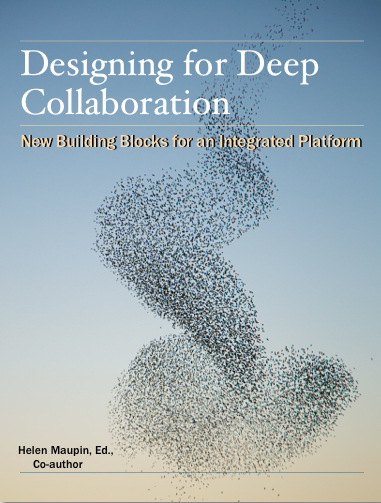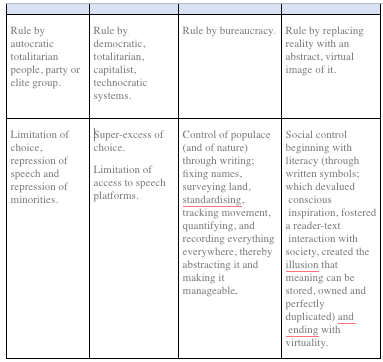… dependence and independence both are extremes.
Life is deep interdependence. Osho
As a proponent of both moderation and collaboration, I recognize in Osho’s words the glaring reality currently faced by humanity. We are not schooled in deep interdependence or what I call deep collaboration. On the whole, we do not play well together in the sandbox called life.
More typically, we adopt nation-states with governance systems favouring dependence from the less-privileged masses and independence for the grossly over-privileged few. We institutionalize and isolate society’s offenders and mentally ill in lieu of embracing their need for rehabilitation, loving-kindness and healing. We exploit and destroy our planetary home without repairing the damage or living more responsibly and in greater balance with our natural surroundings. And in our workplaces, we use technology and machinery to unfairly benefit shareholders by underhandedly overworking and underpaying employees. Unfortunately, these same practices permeate our familial homes where one would hope deep collaboration and loving kindness are rooted.
Pundits might say that global consciousness is waging the classic battle between a dystopian and a utopian way of life. Pessimists are likely to see any or all of the four dystopia as prevailing in today’s world.
| Orwellian | uxleyan | Kafkaesque | Phildickian |
| Rule by autocratic totalitarian people, party or elite group. | Rule by democratic, totalitarian, capitalist, technocratic systems. | Rule by bureaucracy. | Rule by replacing reality with an abstract, virtual image of it. |
| Limitation of choice, repression of speech and repression of minorities. | Super-excess of choice. Limitation of access to speech platforms. | Control of populace (and of nature) through writing; fixing names, surveying land, standardising, tracking movement, quantifying, and recording everything everywhere, thereby abstracting it and making it manageable. | Social control beginning with literacy (through written symbols; which devalued conscious inspiration, fostered a reader-text interaction with society, created the illusion that meaning can be stored, owned and perfectly duplicated) and ending with virtuality. |
On the other hand as early as 1963, optimists like Dr. King, implored humanity to recognize our interdependence and the significance of justice for all living beings.
… I am cognizant of the interrelatedness of all communities and states. I cannot sit idly by in Atlanta and not be concerned about what happens in Birmingham. Injustice anywhere is a threat to justice everywhere. We are caught in an inescapable network of mutuality, tied in a single garment of destiny.
Martin Luther King Jr.
Even more recently, U. S. Presidential hopeful, Marianne Williamson reminded us that separation as opposed to deep connection with each other is a politic of heartlessness.
The idea that we are separate, isolated beings with no deeper connection to one another is the single greatest threat to our happiness and security. Ultimately, none of us will experience the future we all long for if we’re not willing to at least try to love others as we love ourselves.
“Rugged individualism” is a good thing, and an aspect of the American character that has led to greatness. But over the last few decades our rugged individualism has transitioned into rugged narcissism, leading us to live lives too often and in too many ways separate from the people who live around us.
Marianne Williamson, 2019
If what surrounds you appears to be a dystopian, frightening landscape, don’t give up hope. There are many many optimists, myself included, who see the shining light of a just society on the horizon. We know humanity has the physical, mental, emotional and spiritual capacity to create and evolve the deep collaboration and interdependence necessary for greater utopian living—benevolent governments, fair and equal treatment of all, and ensured safety without fear. And we are deeply invested in doing this work everyday.
A profound example of the “social work” that is required to practise deep collaboration occurred for me in co-writing and co-publishing my latest book, Designing for Deep Collaboration: New Building Blocks for an Integrated Platform. My six co-authors and I are organization design consultants distributed across North America. We met f2f and virtually, dialogued, designed, wrote, tested and editted our shared inspiration. Our process of deep collaboration and writing extended over a period of seven years. It takes time to build trusting creative relationships. And, much like the starling murmuration depicted on the book’s cover, we learned from each other, coordinated our efforts and captured the value-added human potential that emerges from deep collaboration. Below is an excerpt from the book.
A World We All Design
The world is a complex place for sure – but we have some things in common. Almost everyone reading these words works and spends a great deal of his or her daily life in some sort of “workplace” with other people, role divisions, goals, budgets and so on. And, what we experience in the 40 or 50 or more hours spent working each week, we carry home with us … to our partners/spouses, to our children, to our neighbours and to others we barely know. We bring home much more than a paycheck. We bring home a variety of experiences and feelings influencing who we are as parents, as siblings, as neighbours, as citizens, as friends. In this sense, “work systems” or if you prefer organizations are pretty important. But what are they really?
Some of us work in complex but relatively traditional organizations where hierarchical, clearly defined jobs and departmental boundaries with top-down “command and control” is the usual way of getting things done. Some of us are fortunate enough to be employed in organizations where authority and decision making are more distributed and shared. In these organizations, even though they are still hierarchies, roles are more flexible and boundaries adjusted based on need.
Even if we “live” in a single seemingly stand-alone organization, many of us find our organizations operate as part of a complex vendor-purchaser value chain. For the most part, the relationships among vendors and purchasers are very much “transactional”— “what can you do for me and at what cost?” In other instances, these working relationships are more characterized by a sense of partnership. In either case, we call these connected work systems networks.
Still others find ourselves members of large, vaguely defined and not-very-connected accumulations of “strange participants.” These often diverse strangers come together, either by governmental direction or through emergent means, to solve complex and seemingly intractable problems—regional poverty, middle east conflicts, climate change, terrorism, global pandemics—facing our whole society. We call these connected work systems eco-systems.
No matter what work system we find ourselves in we all have ideas, hopes and aspirations for doing things differently and better, for our own benefit, for the benefit of our colleagues and “customers” and even for the benefit of the world around us.
The big question is how do we make it happen, with whom, using what sort of tools and ideas?
This book is about those questions … and about some solutions, we (Carolyn, Craig, Don, Doug, Helen and Joe) want to share with you. We invite you to play with these ideas, to build on them and to share them with others. Make them yours and most importantly use them to lift up your spirits in ways that make work more fun and meaningful and in ways that build community.
What if…you could create a place where people enjoy being at work, a place where collaboration is easy and widely used to get work done, a place where “flexibility” is totally natural and normal and where minimal time and effort is needed to coordinate everyone’s work?
If this sounds like Nirvana, Valhalla, or pie-in-the-sky, we don’t blame you but we do invite you to withhold judgement until you have read the remainder of this book. It begins with a historical review that sets the context and foundation from which we, as collaborators and co-authors, evolved a coordination platform for the deep collaboration necessary in today’s workplaces.
I look forward to your feedback once you have read our little book (38 pages). As for the cover image, until very recently not a lot was known about the collaboration required during a starling murmuration. However, here is an interesting fact — seven is the magic number for the birds. Each starling responds not to the entire flock but to its seven closest birds. As co-authors, seven was also our magic number. Hmm, a happy coincidence if you believe in coincidences.






